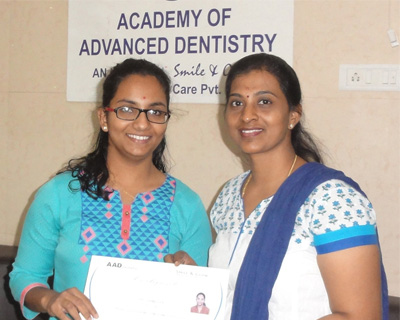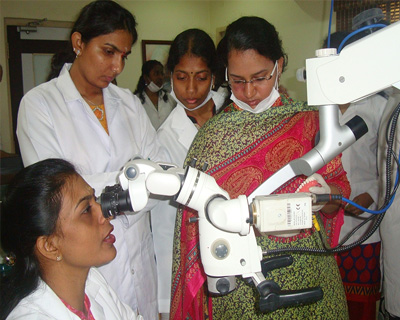Intensive Endodontics

Why This Course
Endodontic training given in the dental college during the under graduation period does not give the confidence for doing quality treatment on patients . So we have customized the course with extensive hands - on training using state of the art equipments and materials which will give you the confidence to do successful endodontic treatment on patients
Course Overview
This course is an eye opener to the world of Endodontics. We start from the basics to the advanced methods and techniques which will make you updated and enhance your confidence to practice endodontics with predictable results.
The hands-on training provide an opportunity for clinical mastery and break through training. Evidence based procedures are clearly demonstrated utilizing the most proven state of the art techniques. It affords an unique learning environment and features an intra oral camera, digital radiography, apex locators, endodontic motors, ultrasonics and handpieces. Every workstation is fully equipped with airotor and micromotor modules and complete armamentarium and supplies necessary to participate fully.
After the course, participants will continue to receive online mentoring and assistance in their journey to becoming successful Practitioners.
ENDODONTICS MICROSCOPE ENHANCED ENDODONTIC EXCELLENCE PROGRAM (2 days)
- Rationale of Endodontic treatment
- Diagnosis and treatment planning
- Preoperative Evaluation
- How to diagnose a case? Various tests and procedures.
- Pulp testing
- Radiography
- Anesthesia in Endodontics – Techniques and Tips to achieve profound anesthesia
- Supplemental Anesthesia
- Role of Antibiotics in Endodontics
- Root canal system anatomy and internal variations in configuration
- Access opening
- Anteriors, premolars, Molars
- SLA-Straight Line Access
- De-roofing
- Orifice location :
- How to locate canals orifices- Extra canal, MB2 canal , Middle mesial canal.
- Pre-flaring the canals
- Glide path prepration
- Working length determination.
- Apex locater
- Rationale of cleaning and shaping
- Working width - the forgotten dimension
- Maximum microbial control of which irrigation to use and when
- passive ultrasonic irrigation
- Apical negative pressure irrigation-Endovac
- Role of intracanal medicaments
- Cleaning and shaping using manual and rotary instruments
- Cleaning and shaping techniques
- Cleaning and shaping of curved canals
- Ledges
- Step back
- Crown down
- Hybrid
- Apical gaging and tug back
- Role of ultrasonics in Endodontics
- Three dimensional obturation
- Lateral condensation
- Warm vertical compaction (WVC)
- Cold lateral compaction (CLC)
- Thermoplastizied obturation
- Squirt technique
- Single sitting endodontics
- Recent advances in endodontics
LIVE DEMONSTRATIONS
- Rubber dam placement
- Access opening in patient
- Working length determination using RVG and Apex locators
- Cleaning and shaping on extracted teeth using hands and rotary instruments in patient
- Three dimensional obscuration
Hands –On exercises
- Access opening in extracted natural teeth (minimum 50 to 60 teeth)
- Orifice enlargement
- Working length determination using RVG and Apex locators
- Cleaning and shaping on extracted teeth using hand and rotary system
- Obturation using
- Lateral condensation
- Single cone technique
ENDODONTICS MICROSCOPE ENHANCED ENDODONTIC EXCELLENCE PROGRAM - 4 days
- Rationale of Endodontic treatment
- Diagnosis and treatment planning
- Preoperative Evaluation
- How to diagnose a case? Various tests and procedures.
- Pulp testing
- Radiography
- Anesthesia in Endodontics – Techniques and Tips to achieve profound anaesthesia
- Supplemental Anesthesia
- Role of Antibiotics in Endodontics
- Root canal system anatomy and internal variations in configuration
- Access opening
- Anteriors, premolars, Molars
- SLA-Straight Line Access
- De-roofing
- Orifice location :
- How to locate canals orifices- Extra canal, MB2 canal, Middle mesial canal.
- Pre-flaring the canals
- Glide path preparation
- Working length determination.
- Apex locater
- Rationale of cleaning and shaping
- Working width - the forgotten dimension
- Maximum microbial control of which irrigation to use and when
- passive ultrasonic irrigation
- Apical negative pressure irrigation-Endovac
- Role of intracanal medicaments
- Cleaning and shaping using manual and rotary instruments
- Cleaning and shaping techniques
- Cleaning and shaping of curved canals
- Ledges
- Step back
- Crown down
- Hybrid
- Apical gaging and tug back
- Role of ultrasonics in Endodontics
- Three-dimensional obturation
- Lateral condensation
- Warm vertical compaction (WVC)
- Cold lateral compaction (CLC)
- Thermoplastizied obturation
- Squirt technique
- Single sitting endodontics
- Recent advances in endodontics
LIVE DEMONSTRATIONS
- Rubber dam placement
- Access opening inpatient
- Working length determination using RVG and Apex locators
- Cleaning and shaping on extracted teeth using hands and rotary instruments inpatient
- Three-dimensional obscuration
Hands-On exercises
- Access opening in extracted natural teeth (minimum 50 to 60 teeth)
- Orifice enlargement
- Working length determination using RVG and Apex locators
- Cleaning and shaping on extracted teeth using hand and rotary system
- Obturation using
- Lateral condensation
- Single cone technique
POST ENDODONTIC RESTORATION
- Principles of post and core
- Anatomical, Biological and Mechanical considerations in restoring Endodontically treated teeth
- Post designs and types
- Tapered Vs Parallel posts
- Metal posts Vs Fiber posts
- Post space preparation (How, When and Where ?)
- Luting cement
- Intra – radicular rehabilitation using FRC
- Ever stick and Ribbond
- Core build-up
- Crown preparation
- Rubberbase impression
LIVE DEMO and HANDS-ON
- Post space preparation
- Try –in of post and assessing with RVG
- Post-placement (FRC post )
- Core build-up
- Crown preparation
- Rubberbase impression
TROUBLESHOOTING IN ENDODONTICS
- Retreatment
- The rationale for Non- surgical RCT
- Restorative disassembly techniques
- Identification /treatment of missed canals
- GP removal using solvents, heat, H-files, rotary
- Ultrasonics in retreatment
- Efficient removal of silver points
- Predictable removal of posts and cores
- Endodontic mishaps: Causes and prevention
- Broken Instrument retrieval
- Blocks: Negotiation and patency
- Ledges: Bypass and management
- Perforation management
- MTA and its applications
- Retreatment of failure Rct.
- Single-visit endodontics
COURSE HIGHLIGHTS
- Assessment of hands on work under microscope
- State of the art –techniques and materials
- Hands-on training on more than 50+ teeth
- Vendor interaction
- Participants will be doing hands-on on patient simulator mannequins,closely mimicking the clinical scenario. This will help to train the doctors to maintain correct operator and patient position.
- Participants will be encouraged to practice indirect vision.
- Loupes are encouraged for more precise work
- Demonstration and evaluation of each step under high precision Microscope ( which helps to eliminate any guess work and helps the participant to see and understand better )
- The participants will have hands on experience with RVG, Intra oral camera, Apex locater, Endo motor, Ultrasonics , Loupe and Microscope during the training period.
- Participants will witness live procedures in patient.
- Limited seats only (3 participants )
- One to one coaching.
- Clinically oriented lectures and hands on
- Clinical tips and tricks
- Case discussions
- Trouble shooting
- After course support
Batch No:
Course Duration : 4 Days
Course Time : 10 am to 4.00 pm
Course Fee: On Request
Instructions to candidates:
Candidates must bring :
- 2 Passport size photo
- Xerox copy of Degree and DCI certificate
- Airotor hand piece
- Slow speed hand piece
- Extracted natural teeth for hands-on
- Loupe (optional)
- Apron
- Loupes will be provided on rental basis as per the requirement of the candidate
*Course fee includes
- Endo kit and materials worth Rs 8000 .
- Working lunch, coffee /tea with refreshment.
All other consumables and non-consumable will be provided by the academy
Authored By :
Prof. Dr. K. S. Senthil Kumar
&
Prof. Dr. S.Hemamalathi












